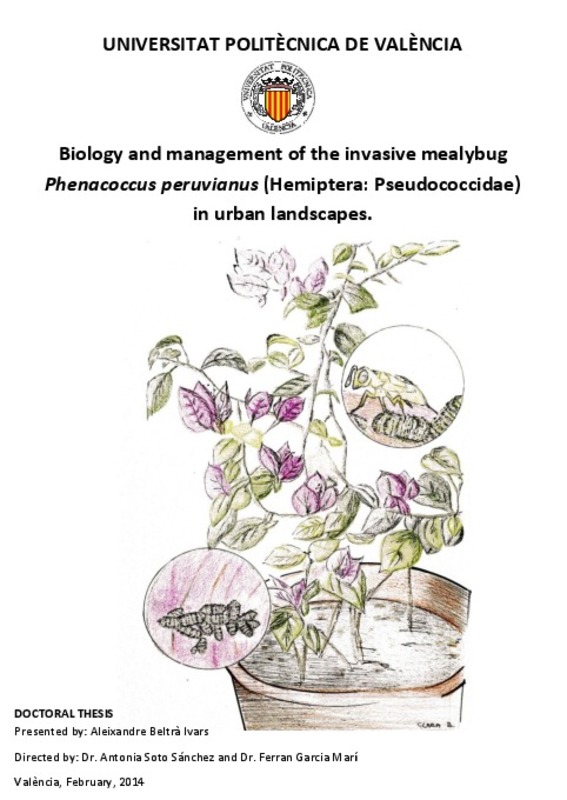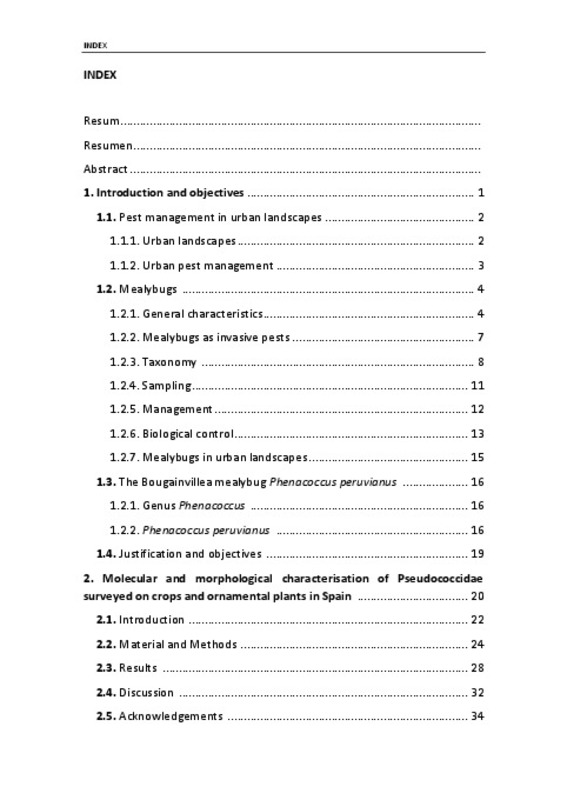- RiuNet repositorio UPV
- :
- Investigación
- :
- Tesis doctorales
- :
- Ver ítem
JavaScript is disabled for your browser. Some features of this site may not work without it.
Buscar en RiuNet
Listar
Mi cuenta
Estadísticas
Ayuda RiuNet
Admin. UPV
Biology and management of the invasive mealybug Phenacoccus peruvianus (Hemiptera: Pseudococcidae) in urban landscapes
Mostrar el registro sencillo del ítem
Ficheros en el ítem
| dc.contributor.advisor | García Mari, Ferran
|
es_ES |
| dc.contributor.advisor | Soto Sánchez, Antonia Isabel
|
es_ES |
| dc.contributor.author | Beltrà Ivars, Aleixandre
|
es_ES |
| dc.date.accessioned | 2014-05-06T06:36:38Z | |
| dc.date.available | 2014-05-06T06:36:38Z | |
| dc.date.created | 2014-04-16T10:00:18Z | es_ES |
| dc.date.issued | 2014-05-06T06:36:35Z | es_ES |
| dc.identifier.uri | http://hdl.handle.net/10251/37233 | |
| dc.description.abstract | Phenacoccus peruvianus (Hemiptera: Pseudococcidae) is an invasive mealybug of Neotropical origin, first reported in the Mediterranean Basin in Almeria (Spain) in 1999. In the following years the mealybug spread into other Mediterranean regions and has also been recorded in Portugal and France, as well as in Sicily, Corsica and the Balearic Islands. Phenacoccus peruvianus is a polyphagous species and damages economically important ornamental plants. Since this was a relatively unknown species, during the first years of invasion, the mealybug was managed by the application of chemical treatments with wide-spectrum pesticides. However, the latest European directive on pesticide use reduces or even forbids pesticide applications in a wide range of urban green areas, giving significant priority to biological control (European Parliament and Council 2009). This thesis sets the basis for introducing biological control into a P. peruvianus management program in urban landscapes, focusing on its characterization, sampling, biology and control. In order to facilitate the identification of this and other mealybug species, we characterised 33 mealybug populations infesting crops and ornamental plants in Eastern Spain, using a combination of molecular and morphological techniques. This characterisation led to the identification of ten mealybug species and made routine identification possible through DNA sequencing or the use of derived species-specific molecular tools. The sequences obtained also add to the phylogenetic knowledge of the Pseudococcidae family and provide insight into the invasion history of some species. Phenacoccus peruvianus populations were high in bougainvillea plants during spring and summer, declining to almost undetectable levels in autumn and winter. The mealybug was mainly found in bracts and there were no significant migrations between plant strata. Phenacoccus peruvianus showed a high aggregated distribution on bracts, leaves and twigs. We recommend a binomial sampling of 200 leaves and an action threshold of 55% infested leaves for IPM purposes in urban landscapes. Its most abundant natural enemies were found to be the primary parasitoids Acerophagus n. sp. near coccois and Leptomastix epona Walker (Hymenoptera: Encyrtidae). We also identified several predator species from the Anthocoridae, Coccinellidae, Chamaemyiidae, and Chrysopidae families. Phenacoccus peruvianus populations were lower during the second and third year of the survey, coinciding with an increase in the parasitoid Acerophagus sp. populations, which displaced the native L. epona. Differential female offspring and resource preemption are discussed as the main reasons for this displacement. To obtain further information on the biology of the new parasitoid Acerophagus sp. we determined some traits of its reproductive and feeding strategies. Acerophagus sp. egg load reached its maximum when it was 5 days old with almost 30 mature eggs. Phenacoccus peruvianus second and third nymphal instars and adults were suitable for parasitism and efficient encapsulation was low (10.76 ± 0.31 %). The parasitoid always preferred older instars when different host instars were available. Acerophagus sp. developed as a solitary parasitoid in the second instar and as a gregarious parasitoid in older instars (2¿4 parasitoids per host). Moreover, it reproduced parthenogenetically and all the emerged offspring were females. Immature development lasted between 20 and 22 days at 25°C and 65% HR. Under these conditions, adults lived for longer than 20 days when fed on honey, but fewer than 3 days when fed on naturally occurring sugar sources (host honeydew and Bougainvillea glabra flowers). | en_EN |
| dc.language | Inglés | es_ES |
| dc.publisher | Universitat Politècnica de València | es_ES |
| dc.rights | Reserva de todos los derechos | es_ES |
| dc.source | Riunet | es_ES |
| dc.subject | Control biológico | es_ES |
| dc.subject | Control biològic | es_ES |
| dc.subject | Biological control | es_ES |
| dc.subject | Pseudococcidae | es_ES |
| dc.subject | Cotonet | es_ES |
| dc.subject | Pseudocóccido | es_ES |
| dc.subject | Mealybug | es_ES |
| dc.subject | Phenacoccus peruvianus | es_ES |
| dc.subject | Parasitoid | es_ES |
| dc.subject | Parasitoid behaviour | es_ES |
| dc.subject | Encyrtidae | es_ES |
| dc.subject | Acerophagus | es_ES |
| dc.subject | Leptomastix | es_ES |
| dc.subject | Urban landscapes | es_ES |
| dc.subject | Áreas verdes urbanas | es_ES |
| dc.subject | Árees verdes urbanes: IPM | es_ES |
| dc.subject | GIP | es_ES |
| dc.subject | Sampling | es_ES |
| dc.subject | Muestreo | es_ES |
| dc.subject | Mostreig | es_ES |
| dc.subject | Dinámica poblacional | es_ES |
| dc.subject | Phenology. | es_ES |
| dc.subject.classification | PRODUCCION VEGETAL | es_ES |
| dc.title | Biology and management of the invasive mealybug Phenacoccus peruvianus (Hemiptera: Pseudococcidae) in urban landscapes | en_EN |
| dc.type | Tesis doctoral | es_ES |
| dc.identifier.doi | 10.4995/Thesis/10251/37233 | es_ES |
| dc.rights.accessRights | Abierto | es_ES |
| dc.contributor.affiliation | Universitat Politècnica de València. Departamento de Producción Vegetal - Departament de Producció Vegetal | es_ES |
| dc.description.bibliographicCitation | Beltrà Ivars, A. (2014). Biology and management of the invasive mealybug Phenacoccus peruvianus (Hemiptera: Pseudococcidae) in urban landscapes [Tesis doctoral no publicada]. Universitat Politècnica de València. https://doi.org/10.4995/Thesis/10251/37233 | es_ES |
| dc.description.accrualMethod | TESIS | es_ES |
| dc.type.version | info:eu-repo/semantics/acceptedVersion | es_ES |
| dc.relation.tesis | 8104 | es_ES |
Este ítem aparece en la(s) siguiente(s) colección(ones)
-
Tesis doctorales [5213]







![MS Word file [Word]](/themes/UPV/images/msword.png)


